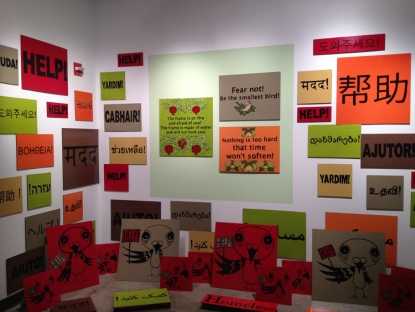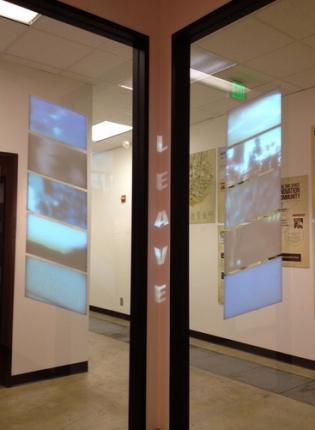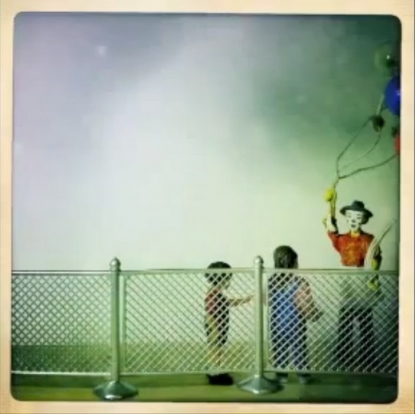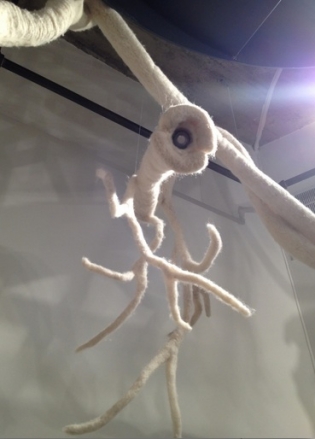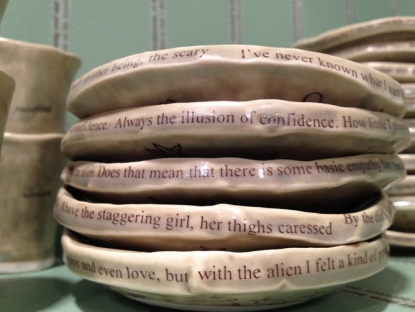Feature: Reviews
Broadside Attractions
- Intersection for the Arts
- April 11-May 26, 2012
Prior to cinemagraphs, comment threads, 140 character limitations, and photography, there were Broadsides. Serving as the primary mode of communication for artists and writers around the turn of the 18th century, it was a way for the artist and writer to relay messages to the public. Although one-sided, broadsides gave the viewer an experience of art regardless of their socio-economic status in that broadsides were posted in public spheres where anyone with the ability to read had access to text and image. With no digital divide or privileged information, the broadside may even be considered an early form of urban art, one based heavily on its environment and region. One example that comes to mind is the consideration of the location and posting of broadsides being dependent on the most highly trafficked areas of a city. However, physical location doesn’t mean too much in regard to the information we send and receive--the constant and instantaneous feedback and engagement of the audience seems to be a facet of social interactions, which spill over into contemporary art. Thus, the importance of showcasing traditional and new forms of interaction in the scope of art and literature is valuable and reflective of how communication has progressed and evolved.
The exhibition, “Broadside Attractions and Vanquished Terrains” curated by Maw Shein Win, Megan Wilson, and Intersection for the Arts director, Kevin Chen, included twelve pairings between artists and writers. The task incorporated a process of interpreting the craft of the broadside based on a film, a piece of music, and a place (real or imagined). Printmaking, drawing, sculpture, painting, and various tools of technologies (i.e., sound, digital photography, etc.) cover the spectrum of mediums used by the collaborating teams. The exhibition does not only explore the concept of the broadside but opens the viewer up to the remnants and byproducts of the creative process of artists and writers, and the relationships between the two. As the viewer reflects on this particular mode of communication, the images, text, space, and performances commingle to revitalize the broadside as the attraction by asking the artist to create an accompanying work show alongside the broadside. With a nod to the "new" technology, it was possible to use your smartphone to access the information the artists and writers used as grist for their mill.
Artist Eliza Barrios projected white, sans serif, block text words in the center of a corner seam of the gallery. Angled rectangles line both sides of the vertical text. These angled boxes contain moving images that led the viewer’s eyes to the words ‘SAINT’, ‘LEAVE’, ‘ANTICIPATION’, and ‘DOMINATRIX’ amongst others. Barrios’s piece served as the signal to the Broadside, it provided the reader with text and images to take on Myron Michael’s words and somehow contextualize them in their imagination. As a minimalist collaborative work, the strong text and non-conventional projection onto flat surfaces created something astute and concise.
With the pervasive use of social media and re-creation of traditional film cameras for the digital age, the stop-motion photography created from the application, Hipstamatic, brilliantly works alongside Cortez’s written work based on time, loss, and memory. Misa Inaoka and Jaime Cortez works were rich in mystery and poignant. Each line of Cortez’s piece, Untitled, tells a story that builds and evolves. In the opening lines of Untitled, for instance, the story of this enigmatic man sets the tone,
It was the 30th of May.
He weighed 300 pounds.
He was 6 foot 3 inches tall.
The water temperature was estimated to be 60 degrees.
The police made the rescue call at to the fire department at 12:30 pm.
Seems like an awful lot of numbers divisible by three for one little suicide.
Similar to Cortez’s text, Inaoka’s stop-motion video tells a story that warrants an almost infinite loop of observation. In the content of each frame, Inaoka seamlessly tells an equally mysterious yet engaging story of miracles and memory through simple transitory compositions. Viewers may find themselves reading the text or watching the stills over and over again to capture something that may have been missed as they gain a different meaning each time. Karrie Hovey and Elise Ficarra (along with Evelyn Ficarra) created a large-scale sculptural piece tmade up of incredibly organic shapes and forms that wrapped around the spiral staircase near the Intersection for the Arts gallery entrance. Walking on the spiraling stairs, forms of deer, antlers, and branches made from felt come into view. Translucent words were sprinkled throughout, and sounds from nature emanated from embedded speakers. The sense of hearing something natural against concrete and metal was reminiscent of the urban landscape where humans try desperately to preserve a sense of the natureal with our rooftop gardens atop corporate buildings and parks surrounded by cars. Hovey and Ficarra’s piece harked back to days when people found themselves outside of the home learning more about life through the written word and their physical environment rather than through a virtual world.
Lastly, audience participation played an integral role in the collaborative work of Liz Worthy and Jenny Bitner. As an exercise in relational aesthetics, Worthy and Bitner take on the idea of Sunday tea complete with friendly interaction. Yet, within the physical space and the objects, such as the tea cups, the table, the dishes, and the cookies, the piece calls upon something deeper from the participant - an intimate moment. Whether the intimate moment was with a friend or one of the artists, an exchange rooted in a reading of Bitner’s piece, Confession expands the idea of intimacy in that it asks the reader to question their own relationships both "real" and "online". The work uses a sense of whimsy and playfulness as it asks participants to ponder their own idea of interaction and engagement with others; in this space, the viewer is asked to engage with objects and people in real time in actual physical space.
The commonality of each collaborative work in the Broadside Attractions and Vanquished Terrains reminds us that even with the endless ability to scroll, “Like”, and reblog the tiny windows we have into each other’s lives, there is something wonderful about returning to a place where our physical senses as well as the mind can engage in concert to create not just a retinal experience but a sensorial one. This exhibition examines and dissects the important relationships between visual artists and writers. The symbiotic nature of these relationships and method of communication prove to be far from blips in the virtual universe. These works reclaim the vanquished terrains taken over by parklets and sky scrapers and asks the viewer to re-imagine a time when you could touch and even feel the written word on paper.
Exhibiting artists also include,
Paul Bridenbaugh | Steve Gilmartin
Keiko Ishihara | Chaim Bertman
Patricia Kelly | Vince Montague
Dwayne Marsh | Nana Twumasi
Nathaniel Parsons | Ly Nguyen
Christine Ponelle | Annice Jacoby
Matthew Rogers | Maw Shein Win
Megan Wilson | Hugh Behm Steinberg
Please visit exhibition web site: http://www.broadsideattractions.com/

